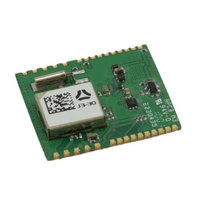J3,3000,00,3.5 Navman Wireless, J3,3000,00,3.5 Datasheet - Page 6

J3,3000,00,3.5
Manufacturer Part Number
J3,3000,00,3.5
Description
MODULE GPS RECEIVER JUPITER 3-30
Manufacturer
Navman Wireless
Datasheet
1.J330DK003.5.pdf
(17 pages)
Specifications of J3,3000,00,3.5
Frequency
1.575GHz
Sensitivity
-159dBm
Data Rate - Maximum
38.4kbps
Modulation Or Protocol
GPS
Applications
GPS
Data Interface
PCB, Surface Mount
Memory Size
4Mb Flash
Antenna Connector
PCB, Surface Mount
Voltage - Supply
3 V ~ 3.6 V
Operating Temperature
-40°C ~ 85°C
Package / Case
Module
Lead Free Status / RoHS Status
Lead free / RoHS Compliant
Features
-
Current - Receiving
-
Other names
943-1011-2
Jupiter 3-30
2.10 Marking/Serialization
The Jupiter 3-30 supports a code 128 barcode indicating the unit serial number. The Navman 13-character serial number
convention is:
3.0 Performance characteristics
3.1 TTFF (Time To First Fix)
TTFF is the actual time required by a GPS receiver to achieve a position solution. This specification will vary with the operating
state of the receiver, the length of time since the last position fix, the location of the last fix, and the specific receiver design.
Aiding is a method of effectively reducing the TTFF by making every start Hot or Warm.
3.2 Acquisition times
Table 3-1 shows the corresponding TTFF times for each of the acquisition modes.
3.3 Timing 1PPS output
The 1 PPS output of the Jupiter 3-30 receiver is accurate to < 1 µs, typical ± 300 ns ref UTC. Refer to Table 6-2 for the default
status on the Jupiter 3-30.
characters1and2: year of manufacture (e.g. 06 = 2006, 07 = 2007)
characters3and4: week of manufacture (e.g. 01 = 1st week of year, 02 = 2nd week of year)
character5: manufacturer code
characters6and7: product and type
character8: product revision
characters9-13: sequential serial number
3.1.1 Hot start
A hot start results from a software reset after a period of continuous navigation, or a return from a short idle period
(i.e. a few minutes) that was preceded by a period of continuous navigation. In this state, all of the critical data
(position, velocity, time, and satellite ephemeris) is valid to the specified accuracy and available in SRAM. Battery
backup of the SRAM and RTC during loss of power is required to achieve a hot start.
3.1.2 Warm start
A warm start typically results from user-supplied position and time initialisation data or continuous RTC operation
with an accurate last known position available in memory. In this state, position and time data are present and valid
but ephemeris data validity has expired.
3.1.3 Cold start
A cold start acquisition results when either position or time data is unknown. Almanac information is used to identify
previously healthy satellites.
Navman Wireless OEM Solutions • 27171 Burbank -Suite 200; Foothill Ranch, CA 92610-2501
TEL: +(949) 461-7150 • FAX: +(949) 461-7860 • www.navmanwirelessoem.com
|
hot start TTFF
warm start TTFF
cold start TTFF
re-acquisition (<10 s obstruction)
mode
Datasheet
Table 3-1: Acquisition times at –125 dBm
500 ms
typ
31 s
33 s
@–125dBm
1 s
90%
<1 s
36 s
38 s
4























